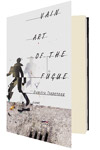The fugue is a baroque-era musical convention in which elements are mixed in such a way that they cannot be recognized. As a compositional strategy for the novel, the fugue reifies the postmodern notion that identity isn’t an essence, but a series of relationships. In Vain Art of the Fugue, a nameless man with flowers attempts to take a bus to the station, and his failure to accomplish this humdrum task is reimagined every chapter. The bus crashes, or the driver throws him off, or throngs of cyclists block his path, or else he finds himself in jail for no reason, where the cops are surprisingly laconic. Sometimes he disappears completely, or just as often ends up at the beach. It is Tsepeneag’s great and strange accomplishment that the novel doesn’t suffer from this anarchy; it profits on its own unique terms. The bus keeps bashing through traffic, but never gets to where it’s going; the driver keeps screaming; the pig in the courtyard of the man’s apartment complex is perpetually slaughtered; and no one picks up Magda—the woman at the station—or differentiates her from Maria, the man’s roommate.
Because it’s tricky to determine the limits of possibility in this world, it helps to contrast the fortunes of the pig and the fish. The pig is repeatedly slaughtered in the courtyard, while three old women—the Fates?—collect its blood. In other words, the pig’s destiny stays the same no matter what else changes in the novel. But the fish, on the other hand, never stops transforming. It first appears in the basket of a cyclist, and keeps popping up impossibly again: “A huge fish drifted over the trees, chased by what looked like a vulture.” “I felt happy stroking the fish nestled at my breast.” “My fish had nodded off in my arms… its blue scales as tiny as a baby’s fingernails.” “Two or three fish—carp or barbell—jumped from the bicycle’s seat rack and tried to run away in the opposite direction.” “It’s not a fish: it’s a child in the shape of a fish.” “He laughed gustily, and pointed to the peasant, or rather to the wicker basket from which the fish’s head had appeared for a few moments.” “A fish was passing, in flight above the garden.” The things of the world are both doomed and perpetually transformed.
The plot is a shuffle of its elements, and Tsepeneag treats characters as...
You have reached your article limit
Sign up for a digital subscription and continue reading all new issues, plus our entire archives, for just $1.50/month.
Already a subscriber? Sign in





